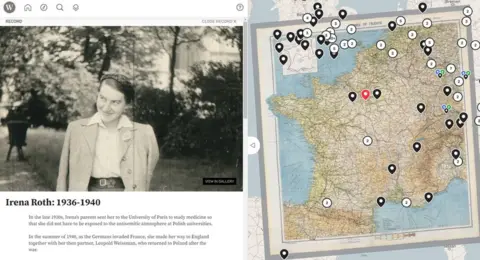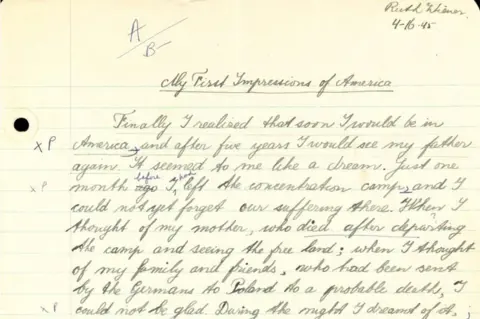Stories of refugees who fled Nazis revealed in online map
 Wiener Holocaust Library
Wiener Holocaust LibraryAn interactive map revealing the stories of refugees who fled Nazi anti-Semitism and persecution during the 20th Century has been launched.
The online resource uses identity papers, diaries and other documents to visually trace the routes taken by people as they moved across Europe.
It has been created by the London-based Wiener Holocaust Library.
Refugee campaigner Lord Alf Dubs said the map would help people "reconnect with their scattered pasts".
The documents used in the refugee map come from the library's collection of family papers.
The institution, in Russell Square, was founded in 1933 to act as the UK's national archive of the Holocaust and genocide. It holds more than one million items in its collection.

Stories from the refugee map
 Wiener Holocaust Library Collections
Wiener Holocaust Library CollectionsHenny Jacoby moved to Berlin in 1928 with her parents, Ludwig and Dorothea and younger brother Hans-Bernd when she was 12. In 1936, she moved to Czechoslovakia where she worked with resistance groups.
She then fled to Poland in 1939 before finally escaping to England with the help of the British Embassy. Her parents and brother stayed behind in Berlin, where they were deported to Auschwitz in March 1943 and killed.
 Wiener Holocaust Library Collections
Wiener Holocaust Library CollectionsPauline Markstein (née Okonski) was born in Poland in 1915. In the 1930s, she moved to Berlin where she worked as an office clerk and married Herbert Markstein.
In 1939 they immigrated to Shanghai to escape Nazi persecution. However, during the Japanese occupation of the city in 1943, refugees were forced into a one-mile area called the Hongkew District.
 Wiener Holocaust Library Collections
Wiener Holocaust Library CollectionsDr Alfred Wiener, who founded Wiener Holocaust Library, escaped Nazi Europe in 1939. However, his wife, Dr Margarethe Wiener, and daughters Ruth, Eva and Mirjam, were trapped in the Netherlands following the outbreak of World War Two.
The group were first sent to Westerbork transit camp before being deported to Bergen-Belsen concentration camp in 1944. In January 1945, Margarethe and her daughters were chosen to be part of a prisoner exchange scheme.
Margarethe died on 25 January 1945 in Switzerland, shortly after regaining her freedom. Ruth, Eva and Mirjam boarded a Red Cross ship bound for New York where they were reunited with their father.

Speaking about the map, Lord Dubs said it had "stirred two emotions in me; sadness at all the lives torn up by war and persecution, but also happiness that at least some of these lives have now been carefully pieced back together".
"Losing connection with the past is a common experience for many refugees. This map helps people reconnect with their scattered pasts," he added.
Enver Solomon, chief executive of Refugee Council, said the "project has great relevance to today's world with people who have fled persecution and oppression desperately seeking safety in the UK having made dangerous journeys overland".
The library plans to add further stories from its collection to the map in the future.
